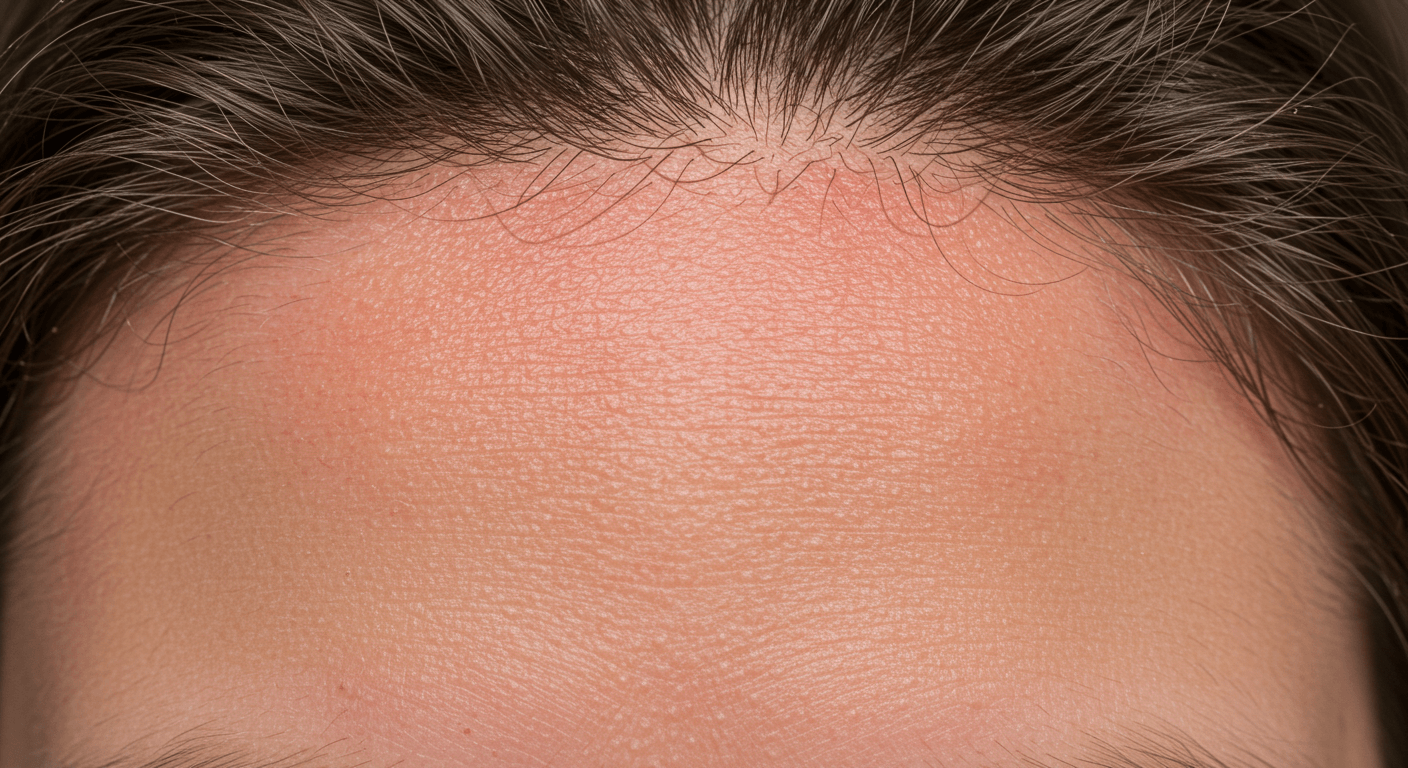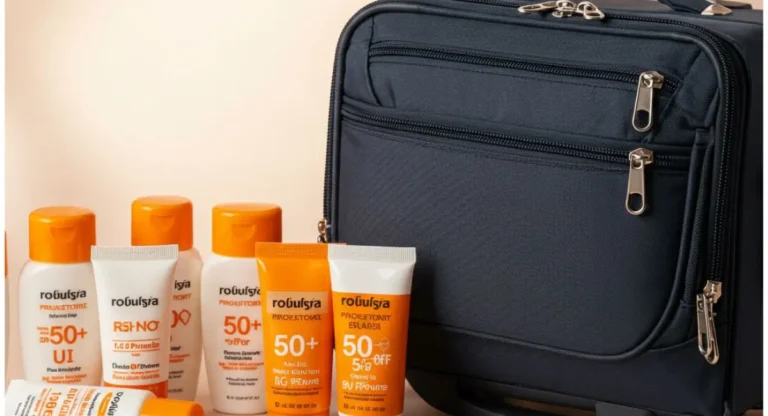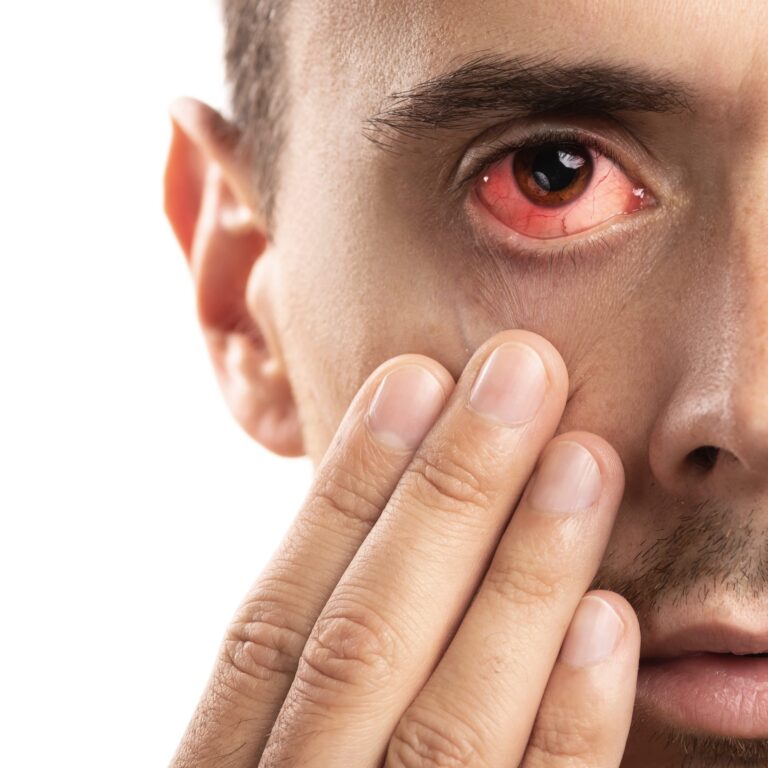How to Prevent Sunburn on Scalp and Protect Your Hairline
Did you know that over 70% of people completely overlook their scalp when applying sunscreen, despite it being one of the most sun-exposed areas of our bodies? This startling statistic reveals a significant blind spot in our sun protection habits. Sunburn on scalp is not only more common than you might think, but it can also be particularly painful and difficult to treat due to the presence of hair and the sensitive nature of the skin on your head. Whether you have thinning hair, a bald spot, or simply part your hair in ways that expose your scalp, understanding how to protect, identify, and treat sunburn on this often-neglected area is essential for complete sun safety.
What Causes Sunburn on the Scalp?
Sunburn on the scalp occurs when the skin on your head is overexposed to harmful ultraviolet (UV) rays from the sun. This exposure damages the DNA in your skin cells, triggering inflammation and the painful symptoms we associate with sunburn. Several factors make the scalp particularly vulnerable:
- Hair Density and Style: Thinning hair, partings, or shaved heads offer less natural protection
- Elevated Position: Your head receives direct sunlight at almost all times when you’re outdoors
- Neglect in Sun Protection: Most people forget to apply sunscreen to their scalp
- Fair Skin and Light Hair: Provides less natural melanin protection against UV rays
- Extended Outdoor Activities: Activities like swimming, hiking, or attending outdoor events increase exposure time
The delicate skin on your scalp can burn in as little as 15 minutes of intense sun exposure, especially during peak hours between 10 AM and 4 PM when UV radiation is strongest.
Sunburn on Scalp Symptoms
Recognizing a sunburned scalp early can help you take prompt action. Common symptoms include:
- Redness and tenderness across exposed areas of the scalp
- Pain and increased sensitivity when touching the affected area or brushing hair
- Itching and burning sensations that may intensify over 24-48 hours
- Swelling of the scalp in severe cases
- Small fluid-filled blisters in more serious sunburns
- Headache due to inflammation and heat exposure
In severe cases, symptoms may also include fever, chills, and nausea, which could indicate sun poisoning and require medical attention.
Sunburn on Scalp: Immediate Treatment Options
If you discover your scalp is sunburned, take these steps immediately to minimize damage and discomfort:
Cool the Burn
Apply a cool, damp cloth to the affected area for 10-15 minutes several times daily. This helps reduce inflammation and provides immediate relief from the burning sensation. Cold compresses can decrease blood flow to the area, reducing swelling and pain.
Gentle Moisture
Apply aloe vera gel directly to the scalp. Research shows pure aloe vera contains compounds that reduce inflammation by up to 48% and accelerates healing time. For maximum benefit, refrigerate the gel before application for additional cooling relief.
Pain Management
Take over-the-counter anti-inflammatory medications like ibuprofen or naproxen sodium to reduce pain, swelling, and redness. These medications work by blocking the production of prostaglandins, which are responsible for inflammation and pain.
Hydration
Increase your water intake substantially. Sunburn draws fluid to the skin’s surface and away from other parts of the body, potentially leading to dehydration. Aim for at least 2-3 liters of water daily while recovering.
Avoid Further Irritation
Skip hot showers, hair dryers, and styling products that contain alcohol or fragrance for at least 48 hours. These can exacerbate irritation and delay healing. Use lukewarm water when washing your hair and pat dry gently rather than rubbing.
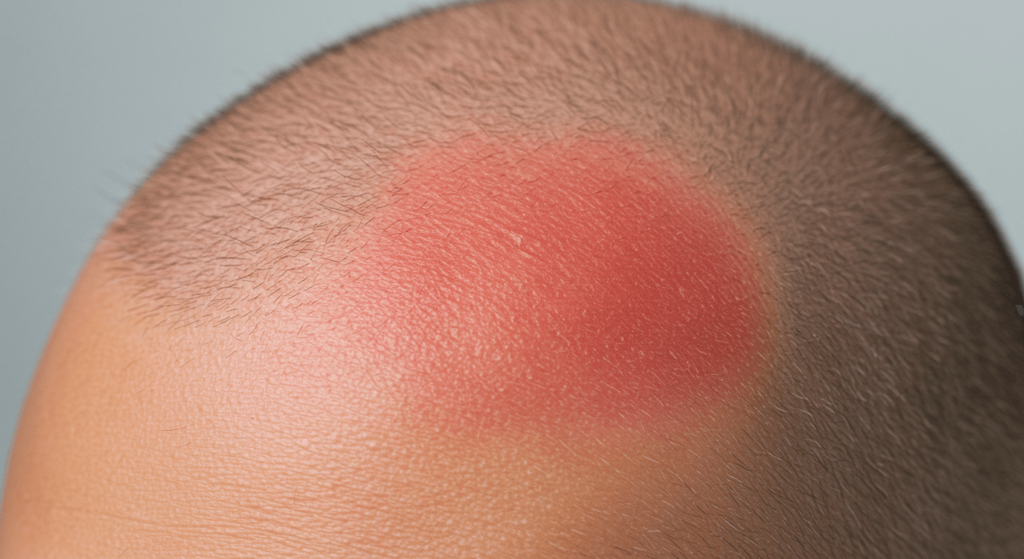
Long-Term Treatment for Healing
Once you’ve addressed the immediate discomfort, focus on supporting the healing process:
Moisturizing Treatments
Apply moisturizing treatments specifically formulated for sensitive skin to help restore the skin barrier. Look for products containing:
- Vitamin E (accelerates healing by up to 17%)
- Ceramides (help rebuild the skin barrier)
- Hyaluronic acid (attracts moisture to damaged skin)
- Colloidal oatmeal (reduces inflammation and soothes irritation)
Gentle Hair Care
Use mild, fragrance-free shampoos and avoid vigorous scrubbing or brushing while your scalp heals. Consider baby shampoo as a gentler alternative during recovery, which has a pH closer to that of human skin and contains fewer irritating ingredients.
Cold Milk Compresses
The lactic acid and fat content in cold milk can provide additional soothing relief. Soak a soft cloth in cold milk and gently press against the sunburned areas for 5-10 minutes. The proteins in milk create a protective film that helps retain moisture in damaged skin.
Calendula Extract
Research shows calendula contains flavonoids that reduce inflammation and promote tissue regeneration. Apply calendula-infused products specifically formulated for sensitive skin to speed healing and reduce discomfort.
Witch Hazel
This natural astringent contains tannins that help reduce inflammation and repair damaged skin. Apply alcohol-free witch hazel with a cotton ball to affected areas for relief from itching and burning.
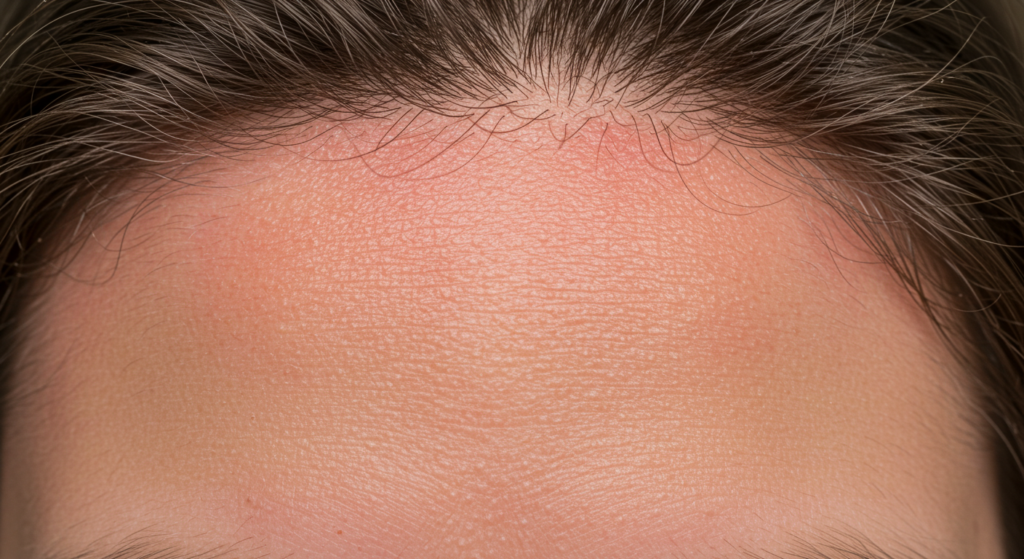
Sunburn on Scalp: When to Seek Medical Attention
While most cases of sunburn on scalp can be treated at home, certain symptoms warrant professional medical care:
- Severe blistering covering more than 20% of the scalp
- Signs of infection (increased pain, swelling, warmth, or pus)
- Fever over 101°F (38°C)
- Extreme pain that doesn’t respond to over-the-counter pain relievers
- Symptoms of heat stroke (confusion, dizziness, rapid heartbeat)
- Persistent symptoms that don’t improve after 7 days
A dermatologist can provide specialized treatments like medicated creams or oral medications to reduce inflammation and prevent complications, particularly if you have other scalp conditions like psoriasis or eczema that might be exacerbated by sunburn.
Sunburn on Scalp: Prevention Strategies
Preventing sunburn on your scalp is far easier than treating it. Implement these effective strategies:
Protective Headwear
Wear wide-brimmed hats (at least 3 inches all around) that provide UPF (Ultraviolet Protection Factor) of 50+ for maximum protection. Studies show that proper headwear can block up to 98% of harmful UV rays. Consider hats specifically designed for sun protection that include:
- Breathable, lightweight fabrics for comfort
- Adjustable fit to prevent being blown off by wind
- Neck coverage for complete protection
- Moisture-wicking properties for comfort in heat
Scalp-Specific Sunscreen
Apply sunscreen formulated specifically for the scalp—these typically have lightweight, non-greasy formulations that won’t make hair appear oily. Look for:
- Minimum SPF 30 (blocks 97% of UVB rays)
- Broad-spectrum protection (guards against both UVA and UVB rays)
- Water-resistant formulations (especially for swimming or sweating)
- Spray or powder formulations for easier application through hair
Reapply every two hours or more frequently if swimming or sweating heavily. For bald spots or thinning areas, be particularly diligent with application.
Protective Hairstyles
If you have longer hair, consider protective styles that cover exposed parts and scalp partings:
- Braids that minimize exposed scalp
- Updos that cover the part line
- Side parts instead of center parts (typically expose less scalp)
- Hats or scarves as fashionable protection options
Timing Outdoor Activities
Plan outdoor activities before 10 AM or after 4 PM when UV radiation is approximately 60% less intense than during midday hours. If you must be outside during peak hours, seek shade whenever possible and be extra vigilant with protection.
Dietary Protection
Certain foods can actually help increase your skin’s natural defense against UV damage. A diet rich in:
- Lycopene (found in tomatoes and watermelon)
- Beta-carotene (in carrots and sweet potatoes)
- Omega-3 fatty acids (in fatty fish and walnuts)
- Vitamin E (in nuts and seeds)
- Polyphenols (in green tea and dark chocolate)
can boost your skin’s natural SPF by up to 20%, according to research. While this doesn’t replace sunscreen, it provides an additional layer of protection.
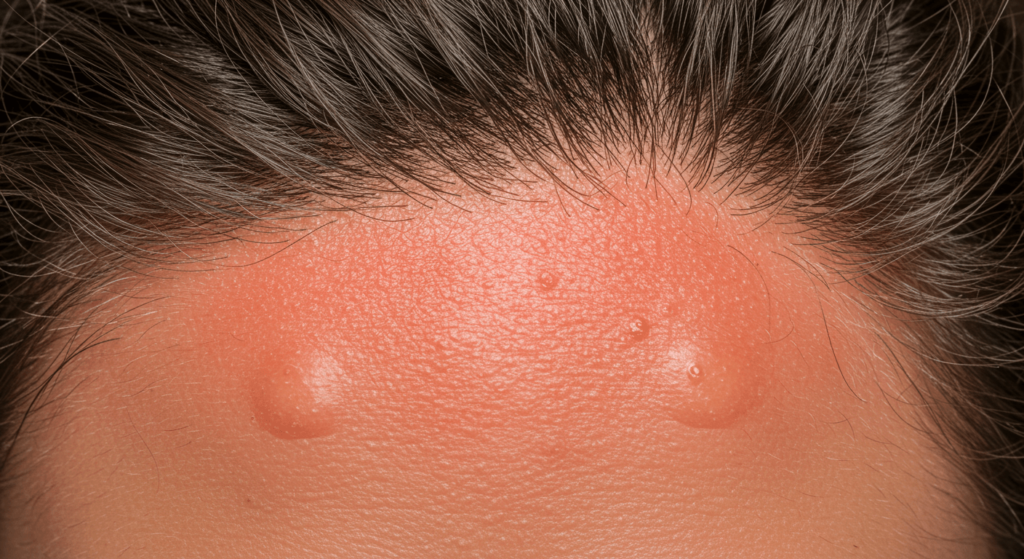
Special Considerations for Different Hair Types
Thin or Fine Hair
Those with thin or fine hair should be especially cautious as more scalp is typically exposed. Consider:
- Higher SPF sunscreens (50+)
- More frequent reapplication
- Daily hat wearing during sunny months
- Specialized scalp sunscreen powders that won’t weigh down fine hair
Bald or Shaved Heads
Without hair protection, the entire scalp is vulnerable. Take these extra precautions:
- Apply sunscreen to your entire scalp as part of your daily routine
- Reapply sunscreen every 90 minutes when outdoors
- Consider dedicated scalp moisturizers with SPF protection
- Always wear a hat for extended outdoor exposure
Textured or Curly Hair
Textured hair may provide more natural coverage but can make sunscreen application challenging:
- Use sunscreen sprays designed to penetrate through hair
- Pay special attention to parts and areas where scalp is visible
- Consider protective styles that fully cover the scalp
- Use moisturizing sunscreens that won’t dry out hair texture
Treating Sunburn on the Scalp While Maintaining Hair Care
Balancing scalp treatment with hair care needs presents unique challenges:
Gentle Cleansing
Use sulfate-free, gentle cleansers that won’t strip natural oils or further irritate the sunburned scalp. Look for shampoos containing:
- Aloe vera
- Cucumber extract
- Chamomile
- Oat derivatives
These ingredients clean effectively while providing anti-inflammatory benefits to damaged skin.
Cooling Treatments
Apply cooling treatments that don’t compromise hair health:
- Refrigerated leave-in conditioners with aloe
- Cucumber and mint scalp toners
- Cold green tea rinses (antioxidants help repair damage)
- Specialized post-sun hair masks with cooling ingredients
Avoiding Heat Styling
Heat styling can exacerbate sunburn discomfort and damage healing skin. Instead:
- Embrace air-drying techniques
- Try heatless styling methods like braiding damp hair for waves
- Use protective styles that don’t require daily manipulation
- Postpone chemical treatments until the scalp is fully healed
Long-Term Scalp Health After Sunburn
After recovering from sunburn, focus on restoring and maintaining scalp health:
Exfoliation
Once healing is complete (typically 7-10 days post-burn), gentle exfoliation helps remove dead skin cells and restore normal scalp function. Choose:
- Chemical exfoliants with gentle AHAs rather than physical scrubs
- Products specifically formulated for sensitive scalps
- Weekly rather than daily exfoliation initially
Strengthening the Skin Barrier
Sunburn damages the skin’s natural protective barrier. Help restore it with:
- Ceramide-containing scalp treatments
- Products with niacinamide (improves barrier function by 30%)
- Scalp oils with essential fatty acids
- Microbiome-supporting ingredients that help restore healthy scalp flora
Regular Scalp Checks
Previous sunburn increases risk for future skin damage. Perform monthly scalp checks:
- Use a handheld mirror and bathroom mirror to examine your entire scalp
- Look for changes in moles or new spots
- Track areas that have been previously burned
- Consider annual dermatological checks if you have a history of severe or frequent sunburns
Dealing with Sunburn On Scalp Peeling After Sunburn
Peeling is a natural part of your scalp’s healing process after sunburn, typically beginning 3-7 days after the initial burn. This process occurs as your body works to shed damaged skin cells and replace them with healthy new ones. While it may be tempting to pick or scrape at peeling skin, doing so can lead to complications and delayed healing.
Sunburn on Scalp: Conclusion
Sunburn on the scalp is a commonly overlooked but potentially serious condition that affects people of all hair types and colors. By understanding its causes, recognizing symptoms early, and implementing proper treatment protocols, you can minimize discomfort and prevent long-term damage. Most importantly, integrating preventative measures like proper headwear, specialized sunscreens, and protective hairstyles into your routine will help keep your scalp healthy and protected year-round. Remember that scalp protection should be part of your comprehensive sun safety strategy, especially if you have thinning hair or spend significant time outdoors.
Have you experienced sunburn on your scalp before? Try implementing these prevention and treatment strategies and share your experience in the comments section below. For more sun safety tips and skin health advice, subscribe to our newsletter for regular updates and expert guidance.
Sunburn on Scalp: FAQs
Can I get sunburned on my scalp even if I have thick hair?
Yes, UV rays can penetrate through hair, especially along part lines or areas where hair is thinner. Even people with thick hair should protect their scalp when spending extended time outdoors.
How long does scalp sunburn typically take to heal?
Most scalp sunburns heal within 3-7 days, though more severe burns may take up to two weeks. sunburn on scalp peeling phase usually begins 3-4 days after the initial burn.
Will a scalp sunburn cause hair loss?
Temporary hair shedding may occur after a severe sunburn due to damage to the hair follicles, but permanent hair loss from a single sunburn is rare. However, repeated sunburns can damage follicles and potentially contribute to long-term thinning.
Are spray sunscreens effective for protecting the scalp?
Yes, spray sunscreens can be effective for the scalp as they’re easier to apply through hair. Look for those specifically formulated for scalp use with at least SPF 30 and broad-spectrum protection.
Can I use regular body sunscreen on my scalp?
While body sunscreen will provide protection, it may leave hair looking greasy or flat. Specialized scalp sunscreens, powders, or sprays are formulated to protect without affecting hair appearance or texture.
Does hair color affect susceptibility to scalp sunburn?
Yes, people with lighter hair colors typically have less melanin in their scalp skin as well, making them more susceptible to UV damage. However, everyone regardless of hair color needs scalp sun protection.
How can I tell the difference between dandruff and peeling from sunburn?
sunburn on scalp peeling typically occurs in larger flakes, may be accompanied by redness, and happens after known sun exposure. Dandruff tends to be smaller flakes, more chronic, and isn’t associated with pain or recent sun exposure.
Is it safe to color or chemically treat hair after a scalp sunburn?
It’s best to wait until your scalp has completely healed (no redness, peeling, or tenderness) before undergoing any chemical hair treatments. This typically means waiting at least 1-2 weeks after a burn.

